Tornado Alley is an area of the US that includes parts of Texas, Kansas, Louisiana, South Dakota, Oklahoma, and Iowa. This area is particularly prone to tornadoes due to surrounding weather patterns. Surrounding states are often also included in tornado alley and experience more frequent tornadoes than states further away from this area. The boundaries of this area are not clearly defined. In general, the area between the Rocky Mountains and the Appalachian Mountains experiences the most tornadoes in the US.
The US state with the most tornadoes is Texas, however, experts believe that is simply due to its size. More area means more room for tornadoes! When you look at it based on tornadoes per 10,000 square miles, Florida wins the prize, followed by Kansas and Maryland.
Let’s dive into 7 of the worst tornadoes in the history of the United States.
What Was the Worst Tornado?
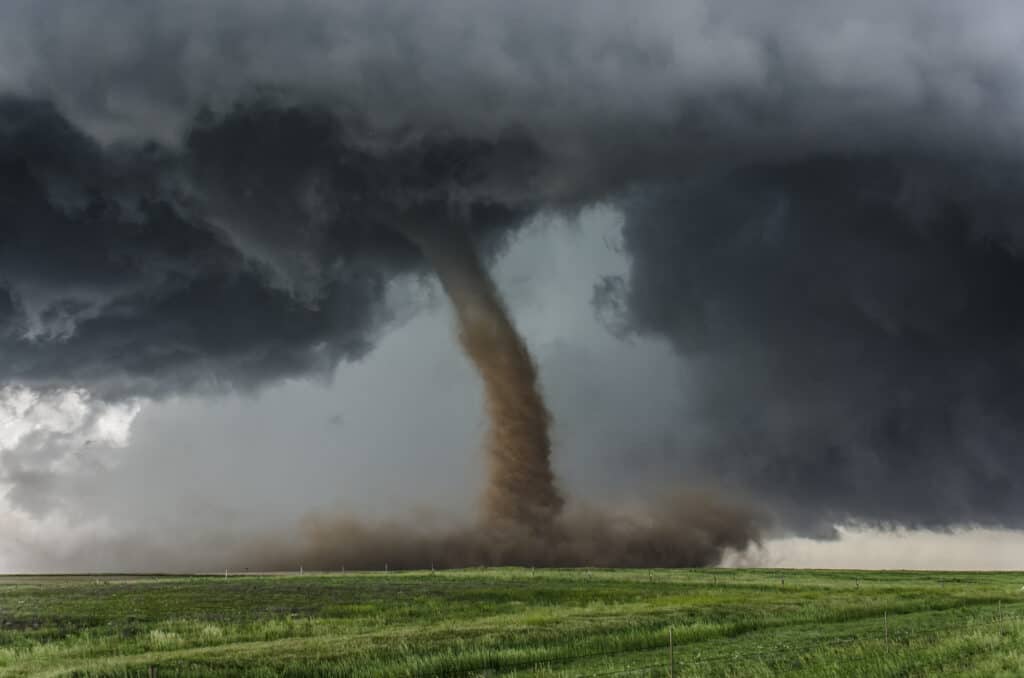
Tornadoes can reach incredible speeds and leave vast swaths of destruction.
©Minerva Studio/Shutterstock.com
There are many ways to determine what is the worst tornado. It could be the longest, the fastest, the most expensive, or the most deadly. The following storms are the worst in many different ways. Which one takes the prize? That might be up to you to decide.

1. The Deadliest and Fastest Tornado Ever
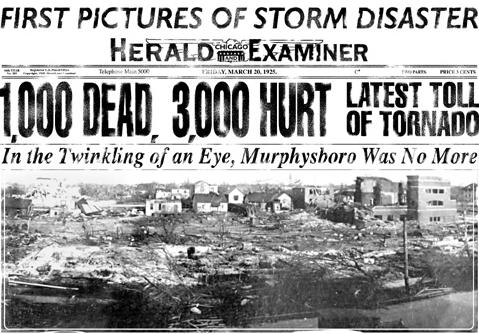
This newspaper, dated two days after the tornadoes, recounts the number of dead and injured.
©A Herald Examiner journalist/Public Domain – License
The deadliest tornado ever happened on March 18, 1925. It is called the Tri-State Tornado because it occurred in three different states: Missouri, Illinois, and Indiana. The F5 tornado, which is also the longest ever, stretched for 219 miles across these three states. It lasted for 3.5 hours and killed 695 people. This tornado was also part of the Tri-State Tornado Outbreak, the deadliest group of tornadoes. Overall, the outbreak killed 747 people.
The tri-state tornado was also the fastest (ground speed). It traveled at about 73 miles per hour.
2. The Most Expensive Tornado

The EF5 tornado that hit Joplin, MO on May 22, 2011, was the deadliest U.S. tornado since 1947.
©Melissa Brandes/Shutterstock.com
A notorious tornado that occurred on May 22, 2011–an EF5 tornado in Joplin, Missouri–was the most expensive tornado to this day. Insurance companies paid out around $2.8 billion dollars, and the total damages are estimated to be $3.18 billion. This tornado killed over 150 people and destroyed between 10-20% of the city of Joplin. It damaged 7,000 homes and 2,000 other structures including the local high school and hospital.
3. The Widest Tornado With the Highest Winds
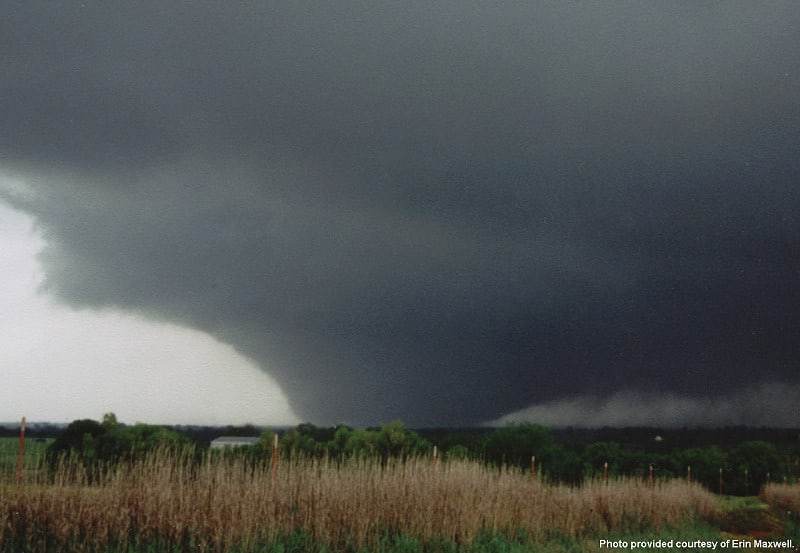
The May 31, 2013 tornado in El Reno Oklahoma with likely wind speeds of 302 miles per hour was estimated to be about 2.6 miles wide.
©Erin D. Maxwell, Public domain – License
Tornadoes are given a minimum possible maximum wind speed, a most likely maximum wind speed, and a maximum possible maximum wind speed based on the conditions observed. In 1999, a tornado in Bridge Creek, Oklahoma likely had a wind speed of 302 miles per hour. Another tornado in 2013 in El Reno, Oklahoma had the same most likely maximum wind speed. That is the fastest ever observed.
The May 31, 2013 tornado in El Reno Oklahoma with likely wind speeds of 302 miles per hour was also the widest. It was estimated to be about 2.6 miles wide. Several storm chasers including Tim Samaras, Paul Young, and Richard Henderson died in this behemoth tornado trying to capture this superlative tornado example. These are the first reported deaths of storm chasers, ever.
Other storm chasers, including Rick Bette from The Weather Channel, also got caught up but escaped with injuries.
The area was not densely populated and the tornado tended to stay over open areas without many people or buildings. However, around 30 buildings and 40 vehicles were destroyed and it took the area about a year to fully rebuild everything. Because of the lack of damage, this tornado was only rated as an EF3 despite the high wind speeds.
4. Most Tornadoes in a 24-Hour Period
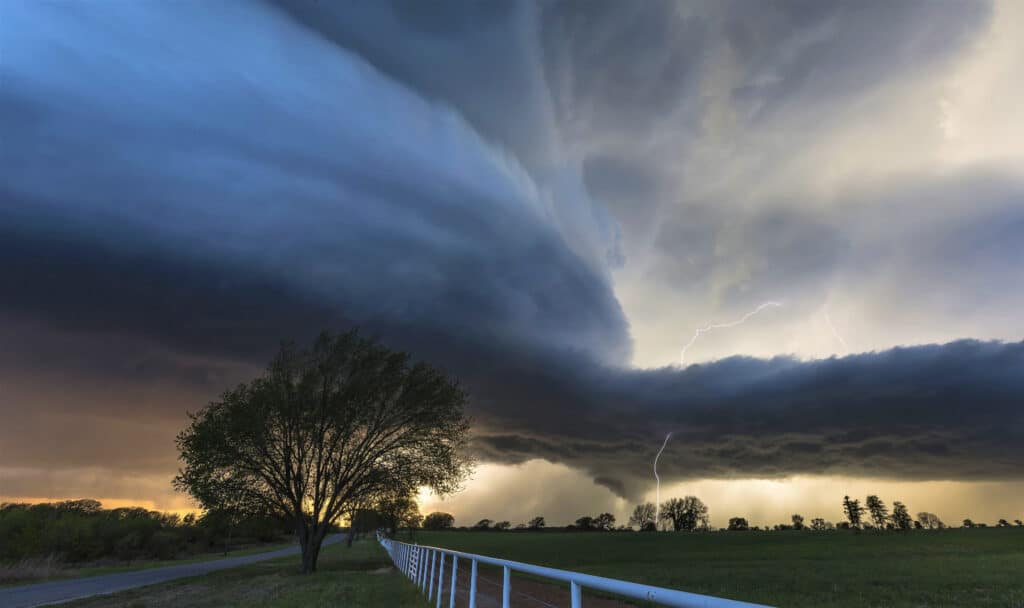
A 2011 outbreak of tornadoes led to 360 different tornadoes in a single system.
©artofvisionn/Shutterstock.com
In 2011 a “super outbreak” of tornadoes occurred on April 27 and 28 in 21 US states and part of southern Canada. On April 27, 216 tornadoes touched down as part of this outbreak. Overall, the storm system had 360 tornadoes. While it isn’t the single most destructive tornado, this storm system as a whole killed 348 people. 324 of the deaths were directly from the insane amount of tornadoes. This entire event cost about $10.1 billion in damage.
Other Destructive Tornadoes
Beyond these records, there have been a number of historic tornadoes. Here are a few of the largest ever recorded.
5. Tupelo, MS

Much of the city was devastated by a major tornado in 1936 that still ranks as one of the deadliest tornadoes in American history.
©Fredlyfish4, CC BY-SA 3.0 – License
On April 5, 1936, an F5 tornado killed over 200 people in Tupelo, MS. It damaged highly populated residential areas and the local hospital, which slowed down medical care during the disaster. Temporary hospitals were set up until the trains got back up and running to bring injured people to hospitals in other cities. The city’s water reservoir was severely compromised. The city had no water or power in addition to floods and fires. It took about a week to clear the roads and allow meaningful aid to get to the town.
6. Gainesville, GA

Gainesville, Georgia was nearly leveled by a massive tornado in 1936.
©iStock.com/Sean Pavone
The very next day, on April 6, 1936, the same storm system caused a destructive F4 tornado in Gainesville, GA. It killed 203 people and fully destroyed four blocks of buildings. In total 750 houses were destroyed and another 250 were severely damaged. Perhaps the most heartbreaking moment of this disaster was when women and children working in a clothing factory went into the basement to take shelter. The building collapsed on them and caught fire, killing 60 people. Due to the fact that there was no water or power, the fire could not be put out quickly. It must have been surreal because those in surrounding towns didn’t know about the tornado or the damage until residents of Gainesville went to those towns to find a working phone.
7. Flint, MI
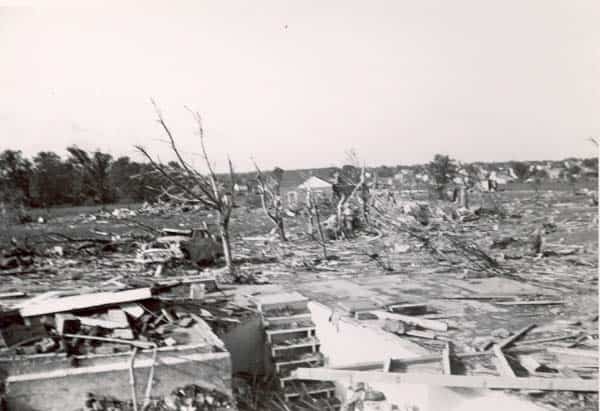
More than 300 homes were destroyed, with another 250 homes sustaining either minor or major damage.
©NOAA, Public domain – License
The year 1953 was a bad year for tornadoes in the United States. On June 8th, 8 tornadoes touched down in the state of Michigan. One of them hit the city of Flint, MI, specifically in the Beecher district. 116 people died in the F5 tornado, including five babies who were less than a year old. Over 800 people got injured. More than 300 homes were destroyed, with another 250 homes sustaining either minor or major damage.
Tornado Categories

You can see how severity can drastically change the amount of damage done by a hurricane.
©Michael Grachikov/Shutterstock.com
When you read about tornadoes, you might see them labeled as F3 or EF3. This refers to tornado categorization based on how much damage the tornado has caused. Scientists and meteorologists have used the Enhanced Fujita Scale since 2007. Before that, they used the Fujita scale, which was a similar scale. Scientists felt that the original scale wasn’t as accurate as it could be, so they developed the new one.
The Enhanced Fujita Scale, or EF Scale, uses the damage observed to estimate the wind speeds in the tornado. It’s important to note that they are not recorded wind speeds.
| Rating | Description | Wind Speed |
|---|---|---|
| EFU | No surveyable damage or more information is needed. Some tornadoes cause damage in areas that are not easily accessible or the damage is not easily visible. | Unknown |
| EF0 | Minor damage. Some small bushes may get uprooted, medium branches fall off trees, and car and building windows break. Structures like sheds or barns are damaged or destroyed. Loose items like patio furniture blow away. | 65-85MPH |
| EF1 | Moderate damage. Sections of a roof may be stripped off houses, siding may get stripped off, doors are blown in, mobile homes fall over, and large trees and telephone poles snap in half. | 86-110MPH |
| EF2 | Considerable damage. Entire roofs come off houses, mobile homes, barns, and other outbuildings may get completely demolished. | 111-135MPH |
| EF3 | Severe damage. Roofs and walls are destroyed, many trees are uprooted, and damage to metal buildings like factories. Large vehicles like buses can get picked up and moved to a new position. | 136-165MPH |
| EF4 | Devastating damage. Homes completely destroyed, trains get blown off tracks, and all outbuildings are leveled. Cars get blown away. | 166-200MPH |
| EF5 | Incredible damage. Homes are completely swept away, cars are thrown very far, huge buildings like skyscrapers and apartment buildings are destroyed or severely damaged, and even grass gets ripped out from the ground. | 200+ MPH |
Have there ever been any F6 tornadoes?
There have not ever been any F6 tornadoes since the official F5 description encompasses the worst damage that can happen and includes any tornado that is above 200 miles per hour without any upper limit.
Tornado Deaths Are Falling

©Sari ONeal/Shutterstock.com
Despite worsening weather and more severe storms, in addition to the population in “tornado alley” growing, there are fewer deaths from tornadoes on average. Experts believe this is due to the development of early warning technologies, faster official communication, and people receiving education on what to do in a tornado. In addition to official communication methods like The Weather Channel and smartphone alerts, social media can also help people get information about severe weather faster, further reducing fatalities and injuries.
Summary of the 7 Worst Tornadoes in the United States
These storms caused the most devastation and loss of life of any other tornadoes in the U.S.:
| Rank | Tornado Type | Location | Date |
|---|---|---|---|
| 1 | Tri-state Tornado | Missouri, Illinois, and Indiana | 3/18/1925 |
| 2 | EF5 | Joplin, Missouri | 5/22/2011 |
| 3 | 302 MPH | El Reno, Oklahoma | 5/31/2013 |
| 4 | Super Outbreak | US, Canada | 4/27,28/2011 |
| 5 | F5 | Tupelo, Mississippi | 4/5/1936 |
| 6 | F4 | Gainesville, Georgia | 4/6/1936 |
| 7 | F5 | Flint, Michigan | 6/8/1953 |
The photo featured at the top of this post is © Rasica/Shutterstock.com
FAQs (Frequently Asked Questions)
What Was the Worst Tornado?
The deadliest tornado ever happened on March 18, 1925. It is called the Tri-State Tornado because it occurred in three different states: Missouri, Illinois, and Indiana. The F5 tornado, which is also the longest ever, lasted for 219 miles across these three states. It lasted for 3.5 hours. It killed 695 people.
What Was the Most Expensive Tornado?
A notorious May 22, 2011 EF5 tornado in Joplin, Missouri is the most expensive tornado to this day. Insurance companies paid out around $2.8 billion dollars, and the total damages are estimated to be $3.18 billion.
What Was the Fastest Moving Tornado?
The tri-state tornado on March 18, 1925 was also the fastest tornado. It traveled at 73 miles per hour.
What tornado had the highest winds?
In 1999, a tornado in Bridge Creek, Oklahoma likely had a wind speed of 302 miles per hour. Another tornado in 2013 in El Reno, Oklahoma had the same most likely maximum wind speed. These are the fastest wind speeds ever for a tornado in the US.
What Was the Widest Tornado?
A May 31, 2013 tornado in El Reno Oklahoma was the widest. It was estimated to be about 2.6 miles wide.
What are Tornado Categories?
The Enhanced Fujita Scale, or EF Scale, uses the damage observed to estimate the wind speeds in the tornado. It’s important to note that they are not recorded wind speeds.
| Rating | Description | Wind Speed |
| EFU | No surveyable damage or more information needed. Some tornados cause damage in areas that are not easily accessible or the damage is not easily visible. | Unknown |
| EF0 | Minor damage. Some small bushes may get uprooted, medium branches fall off trees, car and building windows break. Structures like sheds or barns are damaged or destroyed. Loose items like patio furniture blow away. | 65-85MPH |
| EF1 | Moderate damage. Sections of roof may be stripped off houses, siding may get stripped off, doors are blown in, mobile homes fall over, and large trees and telephone poles snap in half. | 86-110MPH |
| EF2 | Considerable damage. Entire roofs come off houses, mobile homes, barns, and other outbuildings may get completely demolished. | 111-135MPH |
| EF3 | Severe damage. Roofs and walls are destroyed, many trees uprooted, damage to metal buildings like factories. Large vehicles like buses can get picked up and moved to a new position. | 136-165MPH |
| EF4 | Devestating damage. Homes completely destroyed, trains get blown off tracks, all outbuildings are leveled. Cars get blown away. | 166-200MPH |
| EF5 | Incredible damage. Homes are completely swept away, cars are thrown very far, huge buildings like skyscrapers and apartment buildings destroyed or severely damaged, even grass gets ripped out from the ground. | 200+ MPH |
Have there ever been any F6 tornados?
There have not ever been any F6 tornados since the official F5 description encompasses the worst damage that can happen and includes any tornado that is above 200 miles per hour without any upper limit.
Thank you for reading! Have some feedback for us? Contact the AZ Animals editorial team.






